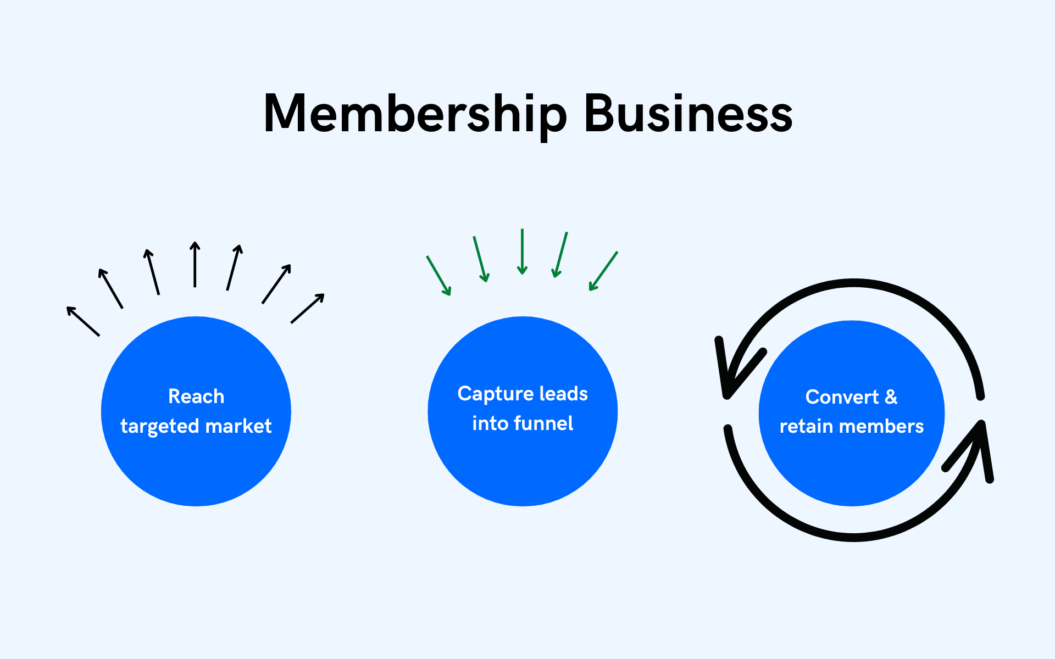There’s a problem taking place in the membership economy, and it’s kind of invisible.
Many creators are seeing high churn rates, low acquisition rates, and – frustratingly – they’re struggling to figure out why.
If you’re facing the same problem in your membership business, stick around as we unpack…
… Ready? Let’s get into it.
You’re Marketing Your Membership Like An eCommerce Store, And It’s Holding You Back
More and more creators are (accidentally) marketing their membership as though it’s an eCommerce business.
And, if you’re constantly seeing…
- High churn from your members
- Disappointing conversion rates
- Little change to your bottom line
… then you’re probably making the same mistake.
It’s an easy mistake to make, which is why so many membership site owners come to us with these same problems and ask:
What the heck is happening?
What’s happening is that the majority of the information out there – especially on Google – is geared towards eCommerce businesses.

These articles, guides, and videos are always packaged as “online” marketing strategies, so it’s hard to tell them apart. After all, you’re also trying to sell stuff online, right?
But there are lots of differences between your business and an eCommerce one, and trying to follow the same marketing practices can really hold you back from seeing success.
So, what are these differences, and why are they responsible for so many problems?
Let’s take a look…
eCommerce vs. Memberships: What’s The Difference?
If you understand the key characteristics that separate eCommerce businesses from membership businesses, you’ll be able to identify the right strategies going forward, and avoid the wrong ones.
Let’s unpack the need-to-know by focusing on the biggest difference between the 2 models: pace.
The eCommerce Model
eCommerce strategies are focused on quick conversations. Especially the ones you see using social media advertising or targeting conversion-driven keywords.
Let me give you an example…
If you’re anything like me, you spend a lot of time on social media. And, if you’re anything like me, you’re easily persuaded by adverts there.
If I see an item that I think is cool, or aligned with other things I’m shopping for, there’s a really high chance I’ll buy the item there and then. (Yes, my bank statements are a mess, thanks for asking.)
It’s much more about the product fitting my needs or hitting emotional triggers than the brand or the content around it. (More on that in a minute.)
Better still, businesses that provide these products take all of the friction out of the process. I can buy a product in 3-5 clicks and then get back to scrolling.
There’s a few reasons behind all of this:
- It allows companies to focus on volume and reach
- It allows them to promote low-ticket purchases that bring new customers in
- It takes the pressure off repeat purchases
The pace this creates means they can focus on customers in, but not really customers out. For lack of a better analogy it’s a “throw enough [expletive] and hope some of it sticks” approach.
This is a slight over simplification; but the key issue is that a lot of the marketing advice you get is focused on supporting those 3 pace-driven elements.
The approach here works well for a lot of businesses, but it goes against the needs of a membership business…
The Membership Model
Unlike eCommerce strategies, good membership strategies force things to happen at a slower pace.
You need to take a slower approach that really exposes people to your content, and creates a long-term trusting relationship before they convert.
Why?
Because this means you will retain more customers long term and build recurring revenue over time.
And, while we’re talking about retention, a mere 5% increase in retention rates can increase profits by between 25% and 95%.
Since strong retention rates are more achievable for memberships, and significantly more profitable than acquiring tons of new members, it makes sense why retention is the core focus that guides membership marketing strategies and business.
Here’s the catch – and the thing that makes eCommerce strategies totally wrong for membership businesses:
In order to retain your members, you need to introduce friction into your marketing in order to attract the right members, and to weed out the wrong ones who are likely to churn.
So, you know, the opposite of what eCommerce businesses are trying to do.
“Introducing friction” simply means that you’re adding more steps between when your leads find your membership, and when they sign-up.
For example, your marketing might push your leads into your funnel, instead of pushing them to your sign-up page to convert right away.
So, when done right, a membership model looks like this:

How to Shift Your Strategy (in 5 Steps)
Now, if you feel a little bit out of your comfort zone when it comes to business and marketing strategies, your instinct is probably to find some sort of guide that will help provide direction.
But, since every membership business is made up of a unique combination of factors, it would be nearly impossible to find a guide that’s tailored perfectly to your exact situation.
Which is why we recommend that you create your own. (With a little help, of course.)
And who better to help you out than your best, most loyal members?
Here’s how you can shift your strategies to align perfectly with your membership, in just 5 steps:
1. Identify your best members.
Make a list of your members who have been with you the longest and who are the most engaged with your content and community.
These members are the perfect blueprint for who you’re trying to attract to your membership, so this is where you want to focus your research.
2. Compile all of the data you have on them.
Comb through your analytics and take note of the behavior of your best members, including:
- The channels they converted through.
- The pricing plan they signed up for.
- The content they engage with most often.
While you should try to collect as much data as possible, having just 1-2 data points for these members will set you off on a strong start.
3. Define your ‘information gap’.
This is where you’ll work out what information is missing from your existing data.
You can start jotting down questions to ask your members, the aim being that their answers will give you everything you need to know about targeting and attracting your ideal audience.
4. Get talking.
This is the fun part, where you get to chat directly with your best members.
You can provide these members with a survey to fill out or, if you have a bit more time on your hands, you can set up a few one-on-one interviews where you can talk through your questions and their answers in real time.
Regardless of how you perform your research, make sure that your questions are easy to understand, and hard to misinterpret.
(You can even show your appreciation for their help by sending them a ‘thank you’ coupon or freebie.)
5. Prioritize your strategies.
Now it’s time to implement what you’ve learned, double-down on what worked to attract and convert your best members, and put the brakes on your less effective strategies.
Start by taking a look at your current strategies, and prioritize what you should shift first based on what you think will have the biggest impact.
It can be tempting to overhaul all of your strategies at once, but it’s best to start small, looking at 1-2 strategies at a time.
This approach might take a little bit more time and effort, but remember: slow and steady wins the membership race.
Wrapping Up…
Content that’s specifically tailored to the eCommerce model has started to dominate Google search results for business and marketing queries. This has created the ‘search trap’, where it’s easy for memberships to adopt the wrong strategies without realizing it.
Since eCommerce businesses are prone to high churn, their strategies are driven by the goal of converting as many new subscribers as possible, as quickly as possible.
Memberships, on the other hand, are primed for high retention rates, so your strategies should be driven by the goal of converting the right members who are likely to retain.
With a little bit of research, and a tiny bit of patience, you’ll be able to shift your strategy away from the eCommerce approach, and towards one that works best for your membership.





